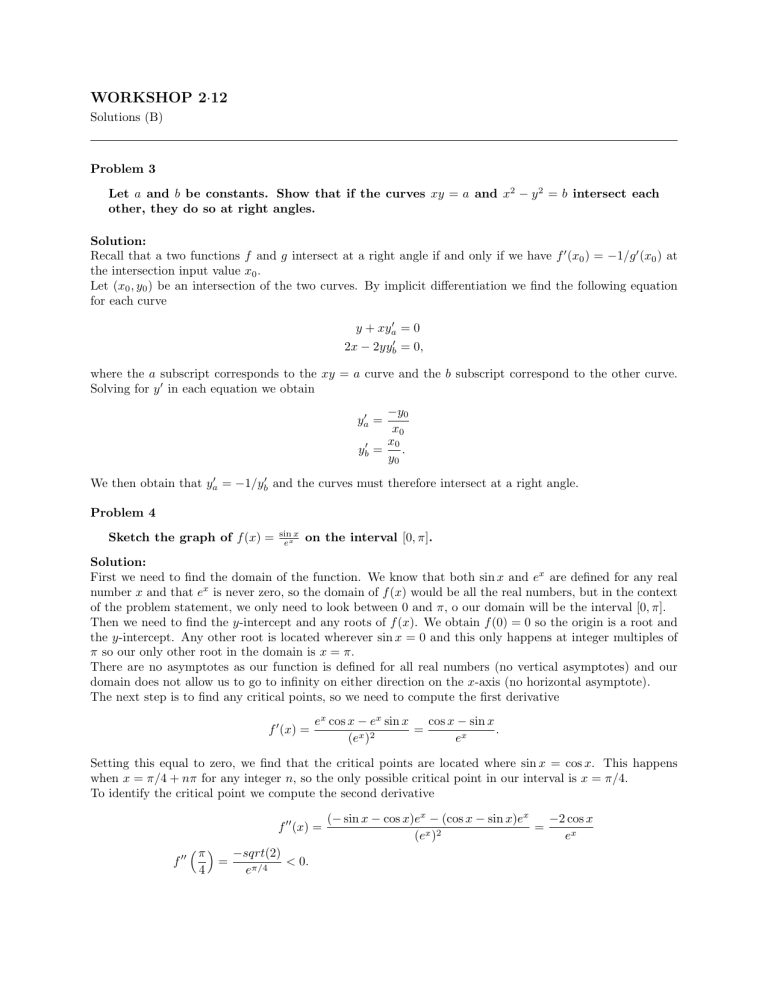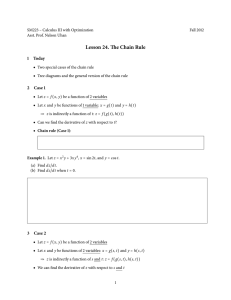·12 WORKSHOP 2

WORKSHOP 2
·
12
Solutions (B)
Problem 3
Let a and b be constants. Show that if the curves xy = a and x 2 other, they do so at right angles.
− y 2 = b intersect each
Solution:
Recall that a two functions f and g intersect at a right angle if and only if we have f 0 ( x
0
) = − 1 /g 0 ( x
0
) at the intersection input value x
0
.
Let ( x
0
, y
0
) be an intersection of the two curves. By implicit differentiation we find the following equation for each curve y + xy
0 a
2 x − 2 yy 0 b
= 0
= 0 , where the a subscript corresponds to the xy = a curve and the b subscript correspond to the other curve.
Solving for y 0 in each equation we obtain y
0 a y
0 b
=
=
− y
0 x
0 x
0 y
0
.
We then obtain that y 0 a
= − 1 /y 0 b and the curves must therefore intersect at a right angle.
Problem 4
Sketch the graph of f ( x ) = sin x e x on the interval [0 , π ] .
Solution:
First we need to find the domain of the function. We know that both sin x and e x number x and that e x is never zero, so the domain of f ( x are defined for any real
) would be all the real numbers, but in the context of the problem statement, we only need to look between 0 and π , o our domain will be the interval [0 , π ].
Then we need to find the y -intercept and any roots of f ( x ). We obtain f (0) = 0 so the origin is a root and the y -intercept. Any other root is located wherever sin x = 0 and this only happens at integer multiples of
π so our only other root in the domain is x = π .
There are no asymptotes as our function is defined for all real numbers (no vertical asymptotes) and our domain does not allow us to go to infinity on either direction on the x -axis (no horizontal asymptote).
The next step is to find any critical points, so we need to compute the first derivative f
0
( x ) = e x cos x − e x
( e x ) 2 sin x
= cos x − sin x e x
.
Setting this equal to zero, we find that the critical points are located where sin x = cos x . This happens when x = π/ 4 + nπ for any integer n , so the only possible critical point in our interval is x = π/ 4.
To identify the critical point we compute the second derivative f
00
π
4
=
− sqrt (2) e π/ 4 f 00 ( x ) =
( − sin x − cos x ) e x − (cos x − sin x ) e x
( e x ) 2
< 0 .
=
− 2 cos x e x
Since the second derivative is negative at the critical point, it will be a local maximum (the value of the function will be
2 e π/ 4 at the local minimum). Moreover we find an inflection point at second derivative is zero there.
x =
π
2 because the
Then we may build a big sign chart for the values of the function and its derivatives in between the critical point, the inflection point and the endpoints x 0 π/ 4 π/ 2 π f ( x ) 0 + + + + + 0 f f
0 ( x ) + + 0 − − − −
00 ( x ) − − − − 0 + +
Following the information about the roots, critical points and inflection point we may sketch the graph of the function and it should look like the following y
√ e
2
π/ 4
0 π x




